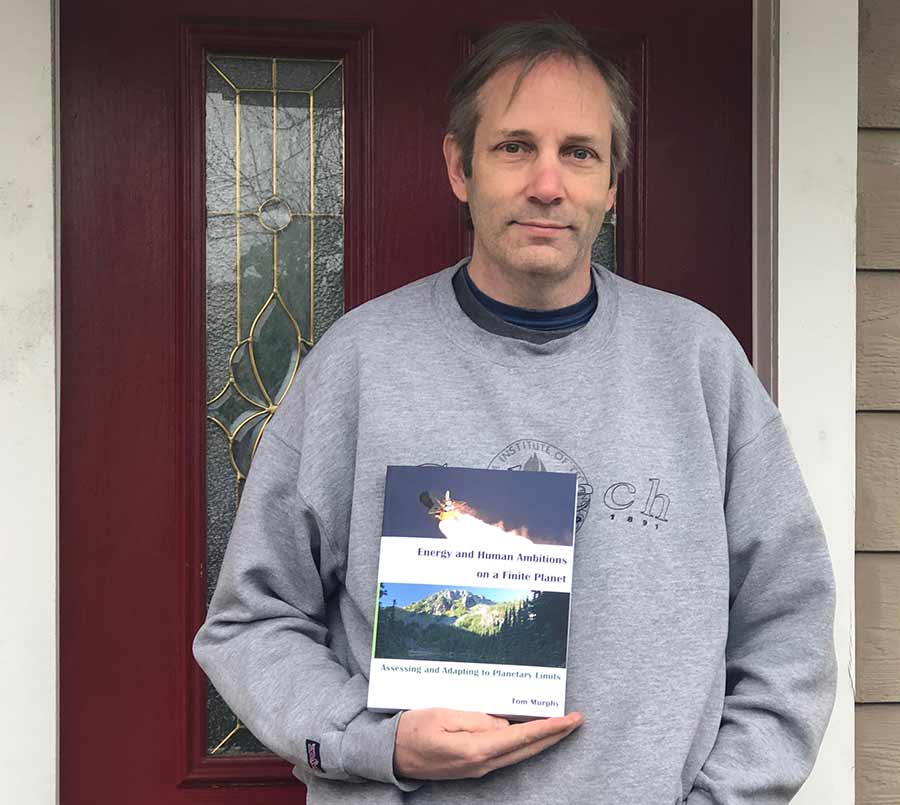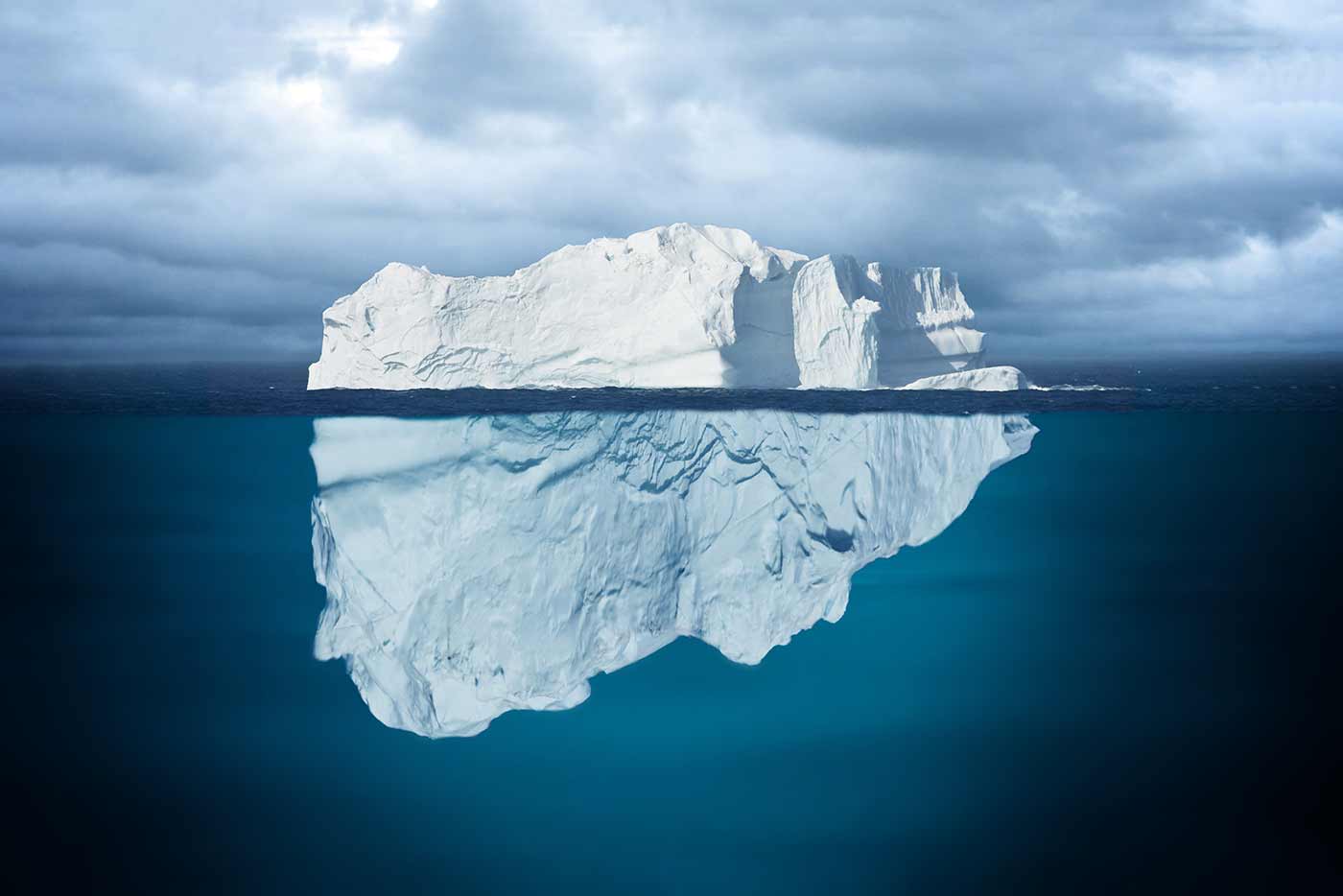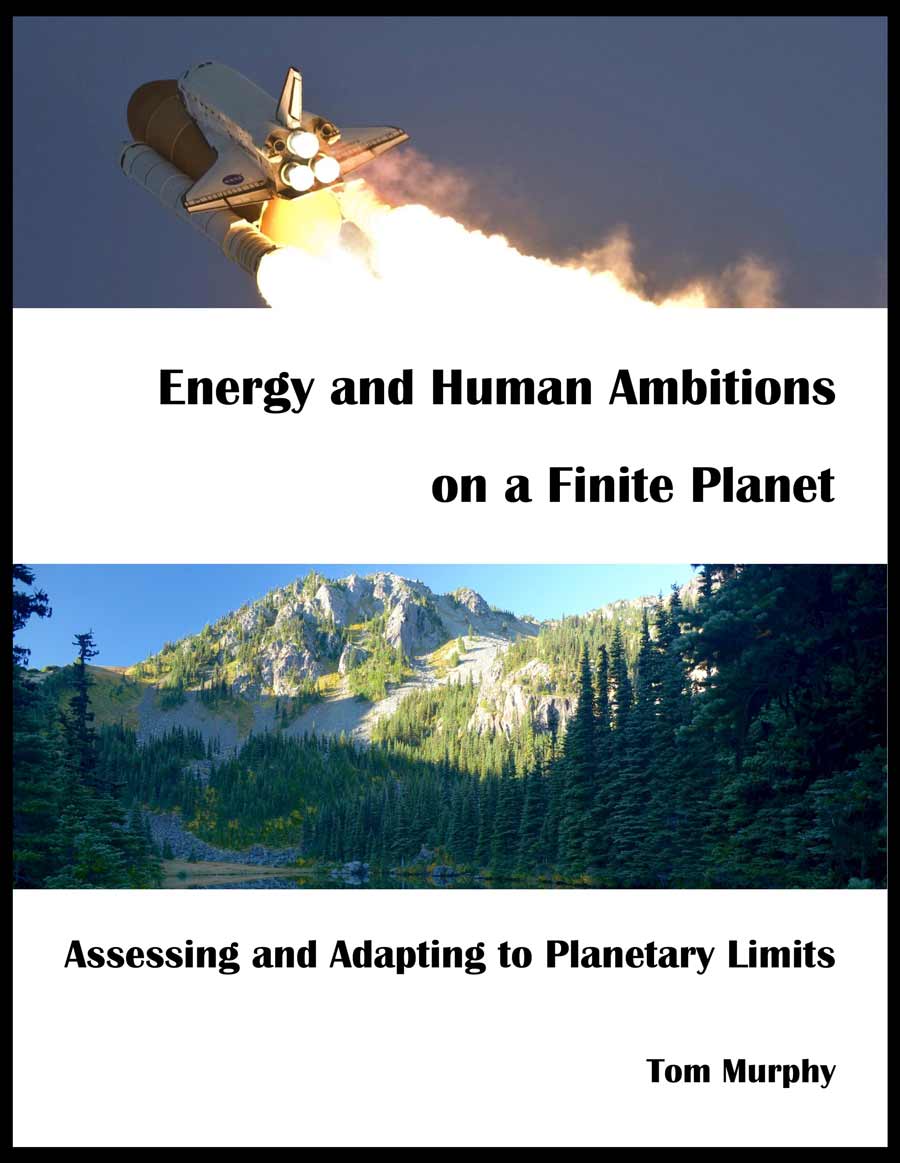By:
- Mario Aguilera
Published Date
By:
- Mario Aguilera
Share This:
A Textbook Case for Heeding Planetary Limits

An astrophysicist takes a rigorous look at Planet Earth and the demands on its resources that will guide its future inhabitability
What on Earth is an astrophysicist doing in the field of planetary conservation? At first glance, UC San Diego Physics Professor Tom Murphy seems like he is far afield when it comes to discussions of sustainability and conserving the planet’s resources. While his traditional research interests have concerned solar system tests of Einstein’s theory of general relativity, Murphy has published a new textbook for general audiences that addresses the fragile state of the planet and its resource limitations. “Energy and Human Ambitions on a Finite Planet” is the product of Murphy’s frustration at not being able to find appropriate textbooks for his students that boldly confront the true state of limits on our planet. If such topics seem a long way from astrophysics, Murphy explains that in the big picture, it all comes down to mass and energy, and that’s where the laws of physics come squarely into play.
Q. Why did you decide to pivot your interests to address the issues surrounding the planet and its energy management?
A. More than a century after the sinking of the Titanic, we’re still just as capable of ignoring an imminent collision on an even grander scale. And just like the iceberg, the bulk of the problem is unseen by most. Climate change pokes up as an evident risk, but growth, energy, resource exploitation, population and ecosystem loss would sink us even without climate change if our course is not altered. As a scientist, I treasure the things we have worked hard to learn about this universe and see a credible risk that we could lose even that in a chaotic collapse that could follow ignorant pursuit of current societal goals.

Photo credit: iStock/oporkka.
I want to get academics and the population at large to take stock of the larger collision course we’re set to execute if continuing business as usual. Climate change is a tiny piece of this larger story, which more fundamentally deals with limits to growth and long-term sustainability in harmony with natural ecosystems. Science provides tools by which to differentiate the possible from impossible, even into the seemingly unimaginable future. The current framework of our civilization falls into the “not possible” category for the long haul.
Q. Your book is dedicated to planet Earth and the hope that we can live within its bounds. What can physics tell us about how we manage the planet’s resources?
A. Resources are measured in kilograms, energy in Joules, rate of energy in watts. The human machine operates within and is bound by physics. The math is simple and says quite clearly that growth cannot continue for much longer, that resources are being exhausted quickly and that ecosystems are disappearing at alarming rates. We’re gnawing on the power cord to our life support system, and enjoying every minute—because we’re good at it. Physics can evaluate how much solar, wind, geothermal, hydroelectric, tidal or wave power is available, and square that against current uses and future projections to show how nearly impossible it is to carry on the unplanned trajectory we’re on now.
Q. You note in the preface that the book may seem pessimistic, that it informs “resigned adaptation” to resource constraints/limitations, rather than tidy solutions. What’s the one thing you hope the book’s readers come away with?
A. I want the book to serve as something like a bucket of cold water, to snap people out of a spell—a spell that arises from never having considered the larger picture or evaluating what future paths are actually possible. The book doesn’t have answers, per se, but hopefully enough awareness to point out that a mindless pursuit of the current path cannot work much longer. It’s time to actually plan for a very long-term future, if we mean to succeed. One theme plucked a number of times in the book is that we were essentially born during a fireworks show (fossil fuels), and that this anomalous experience has cruelly distorted our perspectives about what normal life on this planet looks like. That’s where the bucket of cold water comes in.
Q. What’s the most important takeaway emerging from your book?

A. Margin notes … just kidding. But I’ve been getting a lot of appreciation lately for the margin notes. I don’t yet know what lessons others are taking away. But I myself have arrived at new perspectives in preparing the book, some of which are explored in the last sections of the last appendix. If we wish human civilization to be in its infancy—nearer its beginning than its end—then we have to start ignoring economists and their discount rates and think about very long timescales, placing actual value—in some sense, ultimate value—on the far future. Most of our activities today are patently untenable in the far future. I have started thinking in terms of success and failure, and coming to realize that long-term success is synonymous with “sustainability.” Most of our practices today do not contribute to long-term success and therefore unwittingly serve to advance us toward failure.
Q. Why did you decide to publish your book as an e-textbook?
A. I was inspired by the late David MacKay, who wrote a brilliant book in 2009 called Sustainable Energy—Without the Hot Air. While published in print form by UIT in Cambridge, England, he also released it free as a PDF. To me, this subject is important to share, and not be walled off behind profit motives. As an employed academic, I have the freedom and support to offer my work as a gift. In some sense, the book reflects this lesson as well: greed leads to ultimate failure, so we need to be more selfless in our relationship with Earth. I am delighted that the university is also set up to support and promote open access materials. In its first month online, over 2,000 individuals around the world downloaded the PDF, only half from the U.S. This is a global predicament and requires global awareness. So the decision appears to be supporting global exposure.
Q. What’s been the reaction of your book so far?
A. My mom loves it. My sister likes the feel of the cover (print version available at-cost). A friend cried upon reading the dedication. Some university employees involved in helping me through the process have reported being unexpectedly captivated, intending to read it fully. Students who took the associated course (Physics 12: Energy and the Environment) as I wrote the book’s chapters are excited by its release and have eagerly downloaded or bought the print version, one explaining that it’s the only textbook they’ve bought in college. Colleagues are impressed by the polish, completeness and attention to detail. One suggested that the Biden administration needs to read it, and that Sir David Attenborough needs to be aware of it. It’s written for a general audience: non-science majors in college, for instance. So I hope to learn more about reactions as a broader audience takes it in, and classes begin to use it.
Murphy earned a bachelor’s degree in physics at the Georgia Institute of Technology, then received a Ph.D. on astrophysics research at Caltech. As a postdoctoral researcher at the University of Washington, he initiated a project to test general relativity by measuring the Earth-Moon distance to millimeter accuracy, which he carried to UC San Diego as an assistant professor in 2003. Interest in energy and planetary limits grew over his time at UC San Diego, which is his main focus today. View “Energy and Human Ambitions on a Finite Planet”
Share This:
Stay in the Know
Keep up with all the latest from UC San Diego. Subscribe to the newsletter today.



